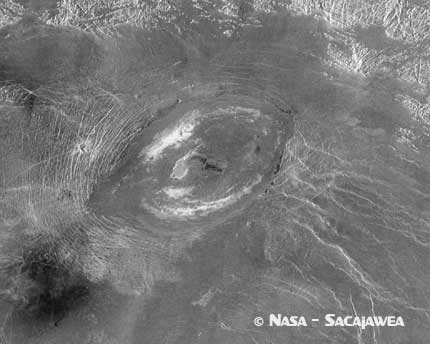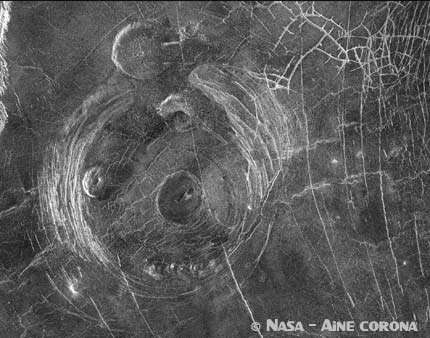|
|
Venus2004.org
> Files
1°) Discovery of the landscape
Venus is a fascinating planet with respect to geology, since its size is comparable to that of the Earth: its diameter is 12 104 km, versus 12 756 km for our home planet. It follows that its area and volume are about 90% and 80% respectively of those of the Earth. Geologists expected that Venus had a heat output similar to that of the Earth, and that its volcanism was comparable.  The mapping of Venus by radar, undertaken by NASA’s Magellan probe from 1990 onwards, indeed brought out the volcanic complexity of Venus. There are no “mid-ocean” ridges there, nor plate tectonics, as on Earth, but rift zones and volcanic provinces of the hot spot variety. Volcanoes are numerous: small cones and domes pepper the plains, and giant shields range up to 500 km in diameter, as well as do “exotic” circular structures named coronae (“crowns”) that seem to represent some unique style of magma circulation under the crust, with surface deformation.  There are 167 large volcanoes on Venus, greater than 100 km in diameter. Coronae are equally numerous. At smaller sizes there are more volcanoes: a total of 1728 larger than 20 km. Smaller ones yet, down to several hundred meters in size, are often grouped in clusters or “fields” of a few hundred units each. The fields total over 50 000 individual small volcanoes, and there are many more on Venus that are scattered throughout the plains. Despite the high number of volcanoes, the Magellan probe did not pick up any ongoing eruption during its three-year survey, which brings to question the current level of activity. |
|
© 2003-2006 Futura-Sciences.com. All rights reserved.
Indexator - Comparateur de prix - Revue de Presse
